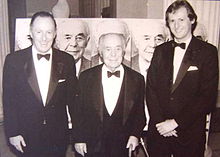Seymour H. Knox II
Seymour H. Knox II | |
|---|---|
 Seymour Knox III, II, and IV in front of Portrait of Seymour H. Knox | |
| Chancellor of the University of Buffalo Acting | |
| In office July 1 – August 31, 1954 | |
| Preceded by | T.R. McConnell |
| Succeeded by | Clifford Furnas |
| Personal details | |
| Born | September 1, 1898 Buffalo, New York |
| Died | September 27, 1990 (aged 92) |
| Spouse | Helen Northrup |
| Children | Seymour Horace Knox III and Northrup Rand Knox |
| Parents |
|
| Education | |
| Alma mater | Yale University (1920) |
| Occupation | Banker |
| Awards | National Medal of Arts (1986) |
Seymour Horace Knox II (September 1, 1898 – September 27, 1990) was a Buffalo, New York philanthropist and polo player. The son of wealthy businessman Seymour H. Knox, he owned a palatial home designed by C. P. H. Gilbert.[1]
Early life
He was born on September 1, 1898 to Grace Millard Knox (1862–1936) and Seymour H. Knox I (1861–1915), who merged his chain of five-and-dime stores with those of his first cousins, Frank Winfield Woolworth and Charles Woolworth, to form the F. W. Woolworth Company in 1912.[2] Knox was one of three children born to Seymour and Grace:
- Dorothy Virginia Knox (1896-1980), who in 1915 married Frank H. Goodyear, Jr. (1891-1930). In 1931, after Goodyear's death, she married Edmund Pendleton Rogers (1882-1966)
- Seymour Horace Knox II (1898-1990)
- Marjorie Millard Knox (1900-1971), who in 1927 married J. Hazard Campbell (1900-1938).[3] In 1948, she married Benjamin Klopp.[4]
Knox attended Nichols School in Buffalo and the Hotchkiss School in Connecticut. He was a 1920 graduate of Yale University. At Yale he was a member of Delta Kappa Epsilon.
Career
Business career
In 1921, upon graduation from Yale, Knox became a Marine Midland Bank director. In 1926, he became vice-president, followed by chairman in 1943 until 1970. He joined the F. W. Woolworth board in 1926 and was chairman from 1943 until reaching the mandatory retirement age forty-five years later in 1971. He became Chairman of The University at Buffalo's governing Council from 1950-69.[5] Knox served on the board of directors of Marine Midland Bank, F. W. Woolworth Company, New York Central Railroad, Penn Central Railroad, and the American Steamship Company.[5]
Art
In 1926, he joined the board of Albright Art Gallery. From the beginning, he was a leader in the modernism movement and in modern cultural life in Buffalo.[6] He spent 60 years working with the Buffalo Fine Arts Academy and by 1939, he was President of the Academy. He bolstered the Contemporary Abstractionism collection during his tenure. He is best known for his 1962 addition to the Albright Art Gallery, designed by Skidmore, Owings & Merrill. After the completion of the addition, the Gallery was renamed the Albright-Knox Art Gallery Knox in his honor. He donated more than 160 works for the new wing, and over 700 pieces over his lifetime.[5] He is said to be in part responsible for the popularity of Jackson Pollock. Under his direction, the Gallery became the first museum to purchase a Clyfford Still, one of the first to purchase a Henry Moore, and as leading champions of Abstractionism, they acquired selections from almost every major abstracionist.[7]
Personal life

In 1923, he married Helen Northrup (1902-1971),[8] who had attended the Albright Art School. The lived in a mansion at 57 Oakland Place in Buffalo, designed by C. P. H. Gilbert. Construction on the home began in 1924 and was a gift to the couple from Knox's mother, who lived nearby at 800 Delaware Avenue.[1] Together, they had two sons:
- Seymour H. Knox III (1926–1996)
- Northrup Rand Knox (1928–1998)
Knox was the subject of the 1985 Andy Warhol painting "Portrait of Seymour H. Knox". He also donated significant funds to the Yale University Art Gallery, in New Haven, Connecticut, which both the Seymour H. Knox, Jr., Curator of Modern and Contemporary Art and Seymour H. Knox, Jr., Curator of European and Contemporary Art positions bear his name. He was an avid polo player and led his Aurora team to the United States Championship in 1932, later touring South America, and winning a tournament in Europe.
Knox died on September 27, 1990 and was eulogized in Congress by U.S. Representative Bill Paxon.[9]
Honors
In 1986, he was awarded the National Medal of Arts[10] by President Ronald Reagan for his contributions to the arts in Buffalo and the nation.[5]
See also
References
- ^ a b Seymour H. Knox, Jr. House excerpt from Oakland Place: Gracious Living in Buffalo by Martin Wachadlo Buffalo Heritage Unlimited (publisher)
- ^ "Seymour Horace Knox". Retrieved March 31, 2007.
- ^ "Joseph Hazard Campbell". www.findagrave.com. Find A Grave Memorial. Retrieved April 12, 2016.
- ^ Ross, Donna (September 26, 2008). "The East Aurora Hunt: Gone But Not Forgotten". The Chronicle of the Horse. Retrieved April 12, 2016.
{{cite news}}: Italic or bold markup not allowed in:|publisher=(help) - ^ a b c d Glueck, Grace (September 28, 1990). "Seymour H. Knox Is Dead at 92; Buffalo Banker Was Art Patron". The New York Times. Retrieved April 12, 2016.
{{cite news}}: Italic or bold markup not allowed in:|publisher=(help) - ^ Goldman, p. 105
- ^ "Shorty's Triumph". Time Magazine. January 12, 1962. Retrieved February 24, 2008.
- ^ "Helen Northrup Knox". www.findagrave.com. Find A Grave Memorial. Retrieved April 12, 2016.
- ^ Paxon, Bill (October 1, 1990). "SEYMOUR H. KNOX, JR., AN EXTRAORDINARY MAN -- HON. BILL PAXON (Extension of Remarks - October 01, 1990)". Library of Congress. Retrieved February 24, 2008.
- ^ "Lifetime Honors - National Medal of Arts". National Endowment For the Arts. Retrieved December 26, 2009.
- Goldman, Mark, "City on The Edge: Buffalo, New York," Prometheus Books, 2007.
